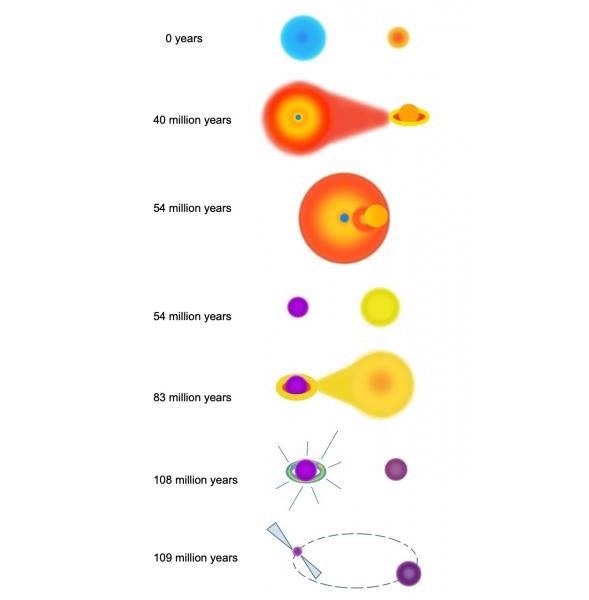Reviewed by Alex SmithJun 13 2022
According to a team of astrophysicists in a recent study that was published in Nature Astronomy, an unexplained signal from the core of the Milky Way could potentially be caused by old and rapidly spinning neutron stars known as millisecond pulsars.
 The main evolutionary stages towards, and beyond, accretion induced collapse of a white dwarf. T = 0 years: A primary and secondary star. T = 44 million years: First interaction after starburst where the primary star undergoes Roche Lobe Overflow as it expands on the main sequence, and the secondary star accretes matter stably. T = 54 million years: The primary star evolves while donating mass to the MS secondary. This is followed by a phase where the binary orbit shrinks and the primary star becomes a Giant Branch Naked Helium star before evolving into an Oxygen/Neon White Dwarf star. T = 83 million years: The primary star continues accreting mass for another 20 million years until the secondary star collapses into a Carbon/Oxygen White Dwarf star. T = 108 million years: The system has remained dormant until now, while spiraling closer via gravitational radiation. T = 109 million years: The Oxygen/Neon White Dwarf star accretes mass from the Carbon/Oxygen White Dwarf star. Once the Ox
The main evolutionary stages towards, and beyond, accretion induced collapse of a white dwarf. T = 0 years: A primary and secondary star. T = 44 million years: First interaction after starburst where the primary star undergoes Roche Lobe Overflow as it expands on the main sequence, and the secondary star accretes matter stably. T = 54 million years: The primary star evolves while donating mass to the MS secondary. This is followed by a phase where the binary orbit shrinks and the primary star becomes a Giant Branch Naked Helium star before evolving into an Oxygen/Neon White Dwarf star. T = 83 million years: The primary star continues accreting mass for another 20 million years until the secondary star collapses into a Carbon/Oxygen White Dwarf star. T = 108 million years: The system has remained dormant until now, while spiraling closer via gravitational radiation. T = 109 million years: The Oxygen/Neon White Dwarf star accretes mass from the Carbon/Oxygen White Dwarf star. Once the Ox
The Fermi-Large Area Telescope’s gamma-ray data from 2009 revealed an inexplicable, apparently dispersed signal from the Milky Way’s core. Researchers have questioned the origin of this “Galactic Center Excess,” with many relying on self-annihilating dark matter.
Recent investigations, on the other hand, have shown evidence that this excess might have originated from an astrophysical source.
The signal could possibly be caused by millisecond pulsars. If this is correct, the Galactic Center Excess might be proof of a new population of astrophysical sources in the Galaxy’s center, which would give information on the Milky Way’s star formation history.
The majority of discussions regarding the millisecond pulsar explanation have been focused on a “recycling” scenario, in which an old neutron star created by a core-collapse supernova gathers material from a binary partner in an X-Ray binary phase and is spun up to millisecond periods.
Oscar Macias, a former Kavli Institute for the Physics and Mathematics of the Universe (Kavli IPMU) Project Researcher (presently GRAPPA Fellow at the University of Amsterdam), led a team of researchers who focused on accretion-induced collapse, a millisecond pulsar formation channel that produces more than half of all millisecond pulsars.
The researchers looked at an accretion-induced-collapse scenario in which an oxygen-neon white dwarf gains mass from its generally low mass binary partner via accretion up to the Chandrasekhar limit (~1.4 solar masses), then collapses to become a neutron star. The collapsing white dwarf’s rotating angular momentum is preserved during the collapse, resulting in the production of a neutron star spinning with millisecond periods or near to them.
The researchers discovered that magnetic flux conservation during the collapse of white dwarf results in an exceptionally strong ultimate neutron star magnetic field. However, neutron stars formed by accretion-induced collapse may potentially undergo additional accretion from a binary partner star in a low-mass X-Ray binary phase, just as in traditional recycling scenarios requiring core collapse.
Due to an asymmetrical explosion mechanism, millisecond pulsars created through this technique do not get any major natal kick as compared to natal kicks imparted to neutron stars emerging from core-collapse supernovae.
It is worth noting that half of the approximately 300-millisecond pulsars discovered so far have been found in globular clusters with low escape velocities and weak gravitational potentials. Millisecond pulsars generated by accretion-induced collapse, on the other hand, are expected to be stuck in the bulge gravitational potential, allowing for a vast population to form over time, which might explain the match between bulge stellar and Galactic center excess morphologies.
The combined gamma-ray emission of a population of millisecond pulsars may explain both the spectrum and total brightness of the Galactic center excess, according to the researchers’ model.
Millisecond pulsars might potentially explain other puzzles in high-energy astrophysics, such as the gamma-ray signal from the nearest neighbor galaxy, Andromeda, according to the researchers.
Their findings were reported in Nature Astronomy on April 28th, 2022.
Journal Reference:
Gautam, A., et al. (2022) Millisecond pulsars from accretion-induced collapse as the origin of the Galactic Centre gamma-ray excess signal. Nature Astronomy. doi.org/10.1038/s41550-022-01658-3.